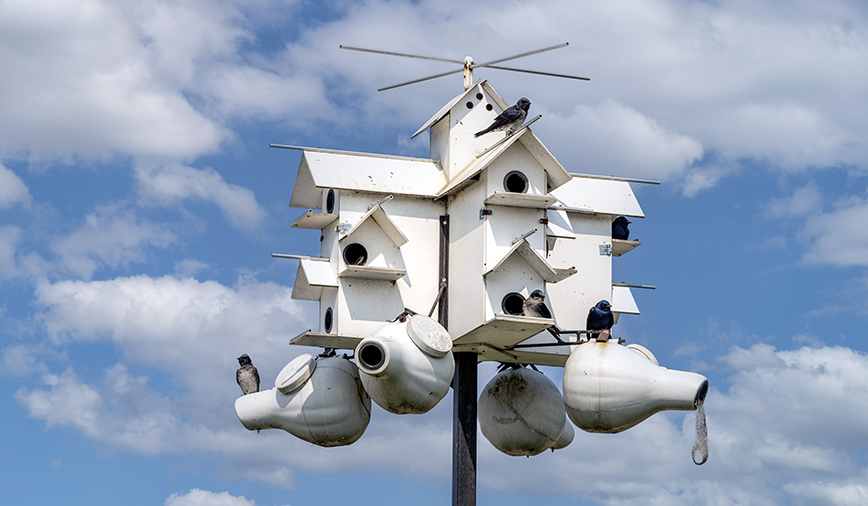If you’re like me (and Heaven help you if you are) you may find yourself faced with a daily barrage of questions, mostly self-imposed, on a wide range of topics. Like, for instance, who decided that dandelions are “bad” and need to be killed? How and why did the myth get started that a mother animal will abandon her babies if a human touches them? And what was it that caused purple martins to switch their nesting preference from natural cavities to those fancy multi-tiered martin housing complexes?
The first two questions are going to require a little research. But, what luck! Answers to the third one popped up with just a couple of Internet clicks.
As it turns out, I’m not the first one to have wondered about purple martin behavior. Entire web sites are devoted to this bird and its unique natural history. Among these, the Purple Martin Conservation Association relates one of the more comprehensive, and readable, tellings of the purple martin tale.
As insectivores that catch their prey on the wing, purple martins are as gifted as they come with regard to short, powerful wings—just the thing for swooping and diving after insects in the sky—as well as broad, flat bills for plucking those bugs from the air. But these nifty adaptations are of little use when it’s time to excavate a cavity—the sort of home these birds require.
And so it is that Progne subis are secondary cavity nesters—that is, they make their homes in the abandoned homes of primary cavity nesters like woodpeckers.
Actually, I should say they used to make their homes in woodpecker holes. But not anymore. At least not here, in the eastern half of the United States.
At some point, and no one’s really sure when, purple martins discovered the benefits of nesting in gourds that had been hollowed out and hung up around the homes of early Native Americans. These gourds, used by the humans as scoops and ladles and such, provided the birds shelter similar to that found in woodpecker cavities, but with one important advantage: Because they were located in such close proximity to people, the gourds largely were avoided by most purple martin predators. The birds could come and go as they pleased, while also raising their young in relative safety.
But the relationship wasn’t just one-sided. The Native Americans also received some benefits from having the martins around. Naturally territorial, martins were great at chasing crows away from food crops and vultures away from drying meats and pelts. There’s also historical evidence suggesting that Native people used the pulverized bodies of purple martins like mothballs, to repel insects and other vermin from furs being stored over the summer.
There’s some conjecture, according to the PMCA folks, that purple martins performed other services too. Always alert to danger, the martins may have acted as an early-warning system for when strangers approached. With their up-withthe-sun ways, perhaps they also functioned as a sort of alarm clock for early risers. And their bubbling songs and constant antics may have provided entertainment for the people, much like radio and TVs do today.
One thing purple martins probably weren’t very effective at was decreasing mosquito populations. Even though the birds often are credited with eating skeeters by the squillions, analyses of stomach contents suggest that mosquitos make up less than 20% of the birds’ diet.
The insect purple martins do eat a lot of is the dragonfly—a voracious insect predator in its own right. In a twist of irony, people erecting purple martin houses in hopes of reducing mosquitos might in fact be causing the opposite effect.
Regardless of reason, the Native Americans’ practice of attracting martins caught on quickly with European settlers, who in turn expanded the housing options beyond gourds to ceramic and wooden structures. By the time the 20th Century rolled around, the birds were nesting almost exclusively in manmade structures. And today, in the eastern half of the United States, purple martins are almost entirely dependent on humans for housing.
At Hickory Knolls, thanks to the efforts of our dedicated volunteer Mike Swanson, a thriving colony of purple martins exists in a row of houses just north of our building, between the athletic fields and garden plots. The first birds arrived back from their South American wintering grounds a couple of weeks ago and, since then, the air has been filled with their constant chatter.

